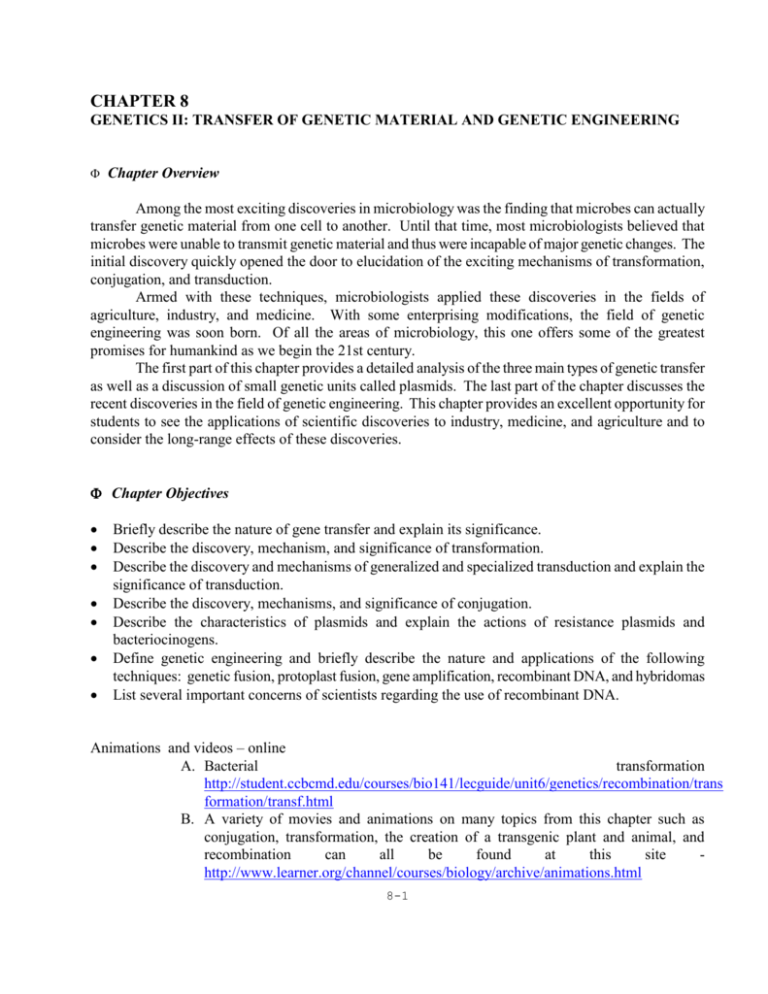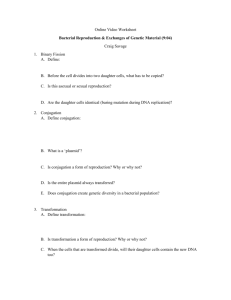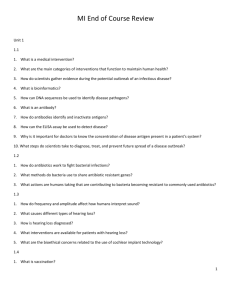Chapter 8 Gene transfer
advertisement

CHAPTER 8 GENETICS II: TRANSFER OF GENETIC MATERIAL AND GENETIC ENGINEERING Chapter Overview Among the most exciting discoveries in microbiology was the finding that microbes can actually transfer genetic material from one cell to another. Until that time, most microbiologists believed that microbes were unable to transmit genetic material and thus were incapable of major genetic changes. The initial discovery quickly opened the door to elucidation of the exciting mechanisms of transformation, conjugation, and transduction. Armed with these techniques, microbiologists applied these discoveries in the fields of agriculture, industry, and medicine. With some enterprising modifications, the field of genetic engineering was soon born. Of all the areas of microbiology, this one offers some of the greatest promises for humankind as we begin the 21st century. The first part of this chapter provides a detailed analysis of the three main types of genetic transfer as well as a discussion of small genetic units called plasmids. The last part of the chapter discusses the recent discoveries in the field of genetic engineering. This chapter provides an excellent opportunity for students to see the applications of scientific discoveries to industry, medicine, and agriculture and to consider the long-range effects of these discoveries. Chapter Objectives Briefly describe the nature of gene transfer and explain its significance. Describe the discovery, mechanism, and significance of transformation. Describe the discovery and mechanisms of generalized and specialized transduction and explain the significance of transduction. Describe the discovery, mechanisms, and significance of conjugation. Describe the characteristics of plasmids and explain the actions of resistance plasmids and bacteriocinogens. Define genetic engineering and briefly describe the nature and applications of the following techniques: genetic fusion, protoplast fusion, gene amplification, recombinant DNA, and hybridomas List several important concerns of scientists regarding the use of recombinant DNA. Animations and videos – online A. Bacterial transformation http://student.ccbcmd.edu/courses/bio141/lecguide/unit6/genetics/recombination/trans formation/transf.html B. A variety of movies and animations on many topics from this chapter such as conjugation, transformation, the creation of a transgenic plant and animal, and recombination can all be found at this site http://www.learner.org/channel/courses/biology/archive/animations.html 8-1 C. Howard Hughes Medical Institute animation on bacterial conjugation http://www.hhmi.org/biointeractive/animations/conjugation/conj_middle_frames.htm D. Annenberg Foundation (registration required) video on genetic transfer http://www.learner.org/vod/vod_window.html?pid=1367 Web Destinations http://www.accessexcellence.org/ Biotechnology activities and teaching modules http://www.protocol-online.net/ Protocols for molecular genetics techniques http://cellbio.com/protocols.html Protocols for molecular genetics techniques http://www.bio.davidson.edu/courses/genomics/methodslist.html Protocols for molecular genetics techniques http://www.mun.ca/biochem/courses/4103/topics/conjugation.html Site deals with bacterial conjugation www.edvotek.com Site provides information about commercially available biotechnology kits for laboratory http://www.biology.arizona.edu/molecular_bio/problem_sets/Recombinant_DNA_Technology/reco mbinant_dna.html Recombinant DNA technology problem set from the University of Arizona Biology Project http://www.biology.arizona.edu/molecular_bio/problem_sets/mol_genetics_of_prokaryotes/Prokary otes.html Molecular genetics of prokaryotes from the University of Arizona Biology Project Discussion Topics (aka. future fodder for essay questions) What are the chances that a microbe could, through methods such as conjugation, become resistant to all known antibiotics? Which organisms are likely candidates and why? Discuss consequences of the inappropriate use of antibiotics to treat viral infections, such as the common cold. Lysogenic viruses are responsible for inserting small bits of information into chromosomes. List several examples in which lysogenic viruses contributed to the virulence of bacteria. Research the production of insulin by genetic recombinant DNA technology. What is the current status of this research, and when is it expected to make an impact for diabetics? Research other drugs and vaccines produced by recombinant DNA technology. 8-2 CHAPTER OUTLINE I. The Types and Significance of Gene Transfer II. Transformation A. Discovery of transformation B. Mechanism of transformation 1. Competence factor 2. Mechanism of insertion C. Significance of transformation III. Transduction A. Discovery of transduction B. Mechanisms of transduction 1. Bacteriophages a. Virulent phages b. Temperate phages c. Lytic and lysogenic cycles d. Prophages 2. Specialized transduction 3. Generalized transduction C. Significance of transduction IV. Conjugation A. Discovery of conjugation B. Mechanisms of conjugation 1. Transfer of F plasmids a. F+ b. Fc. F pilus d. Conjugation bridge 2. High frequency recombinations a. Hfr cells b. Gene transfer 3. Transfer of F' plasmids C. Significance of conjugation V. Gene Transfer Mechanisms Compared VI. Plasmids A. Characteristics of plasmids B. Resistance plasmids 1. Resistance transfer factor (RTF) 2. Resistance genes (R genes) 3. Medical significance 8-3 C. D. VII. G. 4. Displacins Transposons Bacteriocinogens Genetic Engineering A. Definition B. Genetic fusion C. Protoplast fusion D. Gene amplification E. Recombinant DNA technology 1. Recombinant DNA a. Transgenic organisms b. Vectors c. Restriction enzymes d. Restriction fragment length polymorphisms 2. Medical applications of recombinant DNA 3. Industrial applications of recombinant DNA 4. Agricultural applications of recombinant DNA F. Hybridomas 1. Basic mechanism 2. Monoclonal antibodies Weighing the risks and benefits of recombinant DNA See the vocab list at the end of the chapter and make sure you understand these words 8-4









